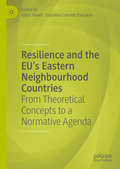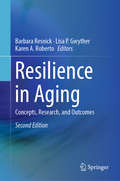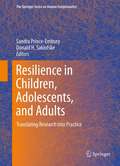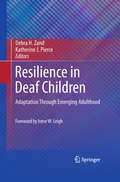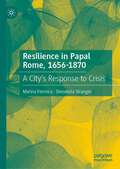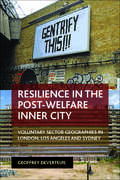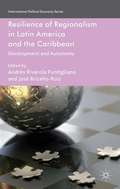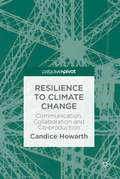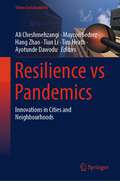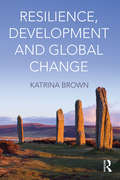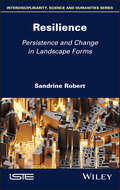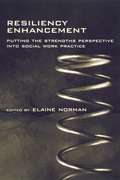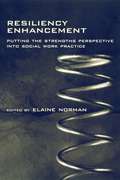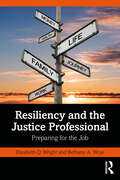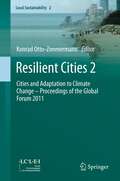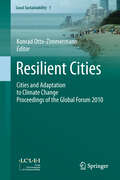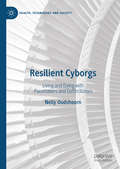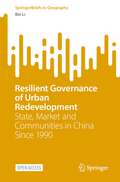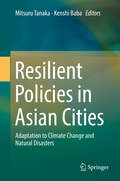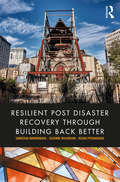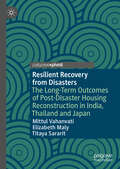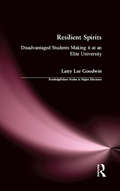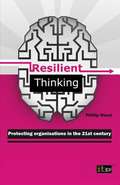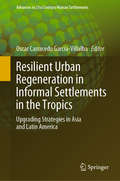- Table View
- List View
Resilience and the EU's Eastern Neighbourhood Countries: From Theoretical Concepts to a Normative Agenda
by Gilles Rouet Gabriela Carmen PascariuResilience has emerged as a key concept in EU foreign policy. The policy debate around this concept has been vigorous, but theoretical attempts to develop the concept are few. Covering fields of strategical importance, such as economic governance; growth and sustainable development; energy, environment and climate action; education, the labour market, and foreign affairs, this book is one of the first attempts to profoundly theorise the concept of ‘resilience’ in international relations by looking at several policy areas and countries. Faced with multiple crises (the economic crisis, the Brexit referendum, the refugee crisis, terrorist attacks, geopolitics such as events in the Ukraine), and challenges with its integration process, the European Union needs to become not only more intelligent, more inclusive and more sustainable, but also more resilient and more capable of reacting to different internal and external shocks. This book integrates a systemic assessment of the regions’ specific shocks and risks in relation to internal vulnerabilities (i.e. structural economic, social, institutional and political fragility) and to their long and medium-term impact on the stability, security and sustainable development in the region.
Resilience in Action
by Michael Ungar Linda LiebenbergMental health specialists and researchers contend that the development of resilience in youth is facilitated at several levels. Relational, cultural, individual, and governmental factors all have a strong influence over the mental well being of young people. Resilience in Action looks at youth interventions with a view to fostering resilience in those living in adverse situations and conditions.In order to provide a practical approach to the issue, the essays in this volume explore the components of successful interventions, encouraging the transmission of effective practices from one community to another across borders. It is organized into four sections, each dealing with a different aspect of work with at-risk youth. The first section focuses on individual health and the ways in which intervention and therapy strengthen personal resources. The second section explores the dynamics of interventions in relation to specific contexts and localized relationships, emphasizing holistic approaches to youth work. A review of the cultural relevance of resilience follows in section three, and the fourth considers ways of increasing the accessibility to resources that encourage healthy development.Featuring contributors from a variety of academic and cultural backgrounds, Resilience in Action offers diverse answers to many of the persistent questions mental health professionals ask regarding how to enhance resilience.
Resilience in Aging: Concepts, Research, and Outcomes
by Karen A. Roberto Barbara Resnick Lisa P. GwytherThis updated and expanded second edition of Resilience in Aging offers a comprehensive description of the current state of knowledge with regard to resilience from physiological (including genetic), psychological (including cognitive and creative), cultural, and economic perspectives. In addition, the book considers the impact of resilience on many critical aspects of life for older adults including policy issues, economic, cognitive and physiological challenges, spirituality, chronic illness, and motivation. The only book devoted solely to the importance and development of resilience in quality of life among older adults, Resilience in Aging, 2nd Edition continues to offer evidence-based theory, clinical guidelines, and new and updated case examples and real-world interventions so professional readers can make the best use of this powerful tool. The critical insights in this volume are concluded with a discussion of future directions on optimizing resilience and the importance of a lifespan approach to the critical component of aging. The book’s coverage extends across disciplines and domains, including: Resilience and personality disorders in older age.Cultural and ethnic perspectives on enhancing resilience in agingSustained by the sacred: religious and spiritual factors for resilience in adulthood and aging.Building resilience in persons with early-stage dementia and their care partners.Interdisciplinary geriatric mental health resilience interventions.Developing resilience in the aged and dementia care workforce.Using technology to enhance resilience among older adults. This wide-ranging and updated lifespan approach gives Resilience in Aging, 2nd Edition particular relevance to the gamut of practitioners in gerontology and geriatrics, including health psychologists, neuropsychologists, clinical psychologists, psychiatrists, social workers, geriatricians, family physicians, nurses, occupational and physical therapists, among others.
Resilience in Children, Adolescents, and Adults
by Donald H. Saklofske Sandra Prince-EmburyResilience in Children, Adolescents, and Adults: Translating Research into Practice recognizes the growing need to strengthen the links between theory, assessment, interventions, and outcomes to give resilience a stronger empirical base, resulting in more effective interventions and strength-enhancing practice. This comprehensive volume clarifies core constructs of resilience and links these definitions to effective assessment. Leading researchers and clinicians examine effective scales, questionnaires, and other evaluative tools as well as instructive studies on cultural considerations in resilience, resilience in the context of disaster, and age-appropriate interventions. Key coverage addresses diverse approaches and applications in multiple areas across the lifespan. Among the subject areas covered are: - Perceived self-efficacy and its relationship to resilience. - Resilience and mental health promotion in the schools. - Resilience in childhood disorders. - Critical resources for recovering from stress. - Diversity, ecological, and lifespan issues in resilience. - Exploring resilience through the lens of core self-evaluation. Resilience in Children, Adolescents, and Adults is an important resource for researchers, clinicians and allied professionals, and graduate students in such fields as clinical child, school, and developmental psychology, child and adolescent psychiatry, education, counseling psychology, social work, and pediatrics.
Resilience in Deaf Children
by Katherine J. Pierce Debra H. Zand<P>Historically, the diagnosis of deafness in a child has been closely associated with profound disability, including such typical outcomes as unmet potential and a life of isolation. A major shift away from this negative view has led to improved prospects for deaf children. <P>Resilience in Deaf Children emphasizes not only the capability of deaf individuals to withstand adversity, but also their positive adaptation through interactions with parents, peers, school, and community. In this engaging volume, leading researchers and professionals pay particular attention to such issues as attachment, self-concept, and social competence, which are crucial to the development of all young people. In addition, the volume offers strategies for family members, professionals, and others for promoting the well-being of deaf children and youth. <P>Coverage includes: <br>Attachment formation among deaf infants and their primary caregivers.<br>Deaf parents as sources of positive development and resilience for deaf infants.<br>Enhancing resilience to mental health disorders in deaf school children.<br>Strength-based guidelines for improving the developmental environments of deaf children and youth.<br>Community cultural wealth and deaf adolescents' resilience.<br>Self-efficacy in the management of anticipated work-family conflict as a resilience factor among young deaf adults.<br>Resilience in Deaf Children is essential reading for researchers, clinicians, and graduate students in clinical child, school, and developmental psychology as well as for allied researchers and professionals in such disciplines as school counseling, occupational therapy, and social work.
Resilience in Papal Rome, 1656-1870: A City's Response to Crisis
by Donatella Strangio Marina FormicaThis book analyses the evolution of the city of Rome, in particular, papal Rome, from the plague of 1656 until 1870 when it became the capital of the Kingdom of Italy. The authors explore papal Rome as a resilient city that had to cope with numerous crises during this period. By focusing on a selection of different crises in Rome, the book combines cultural, political, and economic history to examine key turning points in the city’s history. The book is split into chapters exploring themes such as diplomacy and international relations, disease, environmental disasters, famine, public debt, and unravels the political, economic, and social consequences of these transformative events. All the chapters are based on untapped original sources, chiefly from the State Archive in Rome, the Vatican Archives, the Rome Municipal Archives, the École Française Library, the National Library, and the Capitoline Library.
Resilience in the Post-Welfare Inner City: Voluntary Sector Geographies in London, Los Angeles and Sydney
by Geoffrey DeVerteuil'Resilience' has become one of the first fully fledged academic and political buzzwords of the 21st century. Within this context, Geoffrey DeVerteuil proposes a more critically engaged and conceptually robust version, applying it to the conspicuous but now residual clusters of inner-city voluntary sector organisations deemed ‘service hubs’. The process of resilience is compared across ten service hubs in three complex but different global inner-city regions – London, Los Angeles and Sydney – in response to the threat of gentrification-induced displacement. DeVerteuil shows that resilience can be about holding on to previous gains but also about holding out for transformation. The book is the first to move beyond theoretical works on ‘resilience’ and offers a combined conceptual and empirical approach that will interest urban geographers, social planners and researchers in the voluntary sector.
Resilience of Regionalism in Latin America and the Caribbean: Development and Autonomy (International Political Economy)
by Andrés Rivarola Puntigliano José Briceño-RuizAs regionalisation becomes an increasingly hot topic, the authors explain why regionalism has been most successful in Latin America and analyse current processes and opinions of possible future developments in the region, including the Caribbean, Central America, Brazil, and Mexico.
Resilience to Climate Change: Communication, Collaboration and Co-production
by Candice HowarthThe frequency and intensity of climate shocks such as heatwaves and flooding, are expected to increase under a changing climate with severe implications across the food, energy, water, environment nexus. This book critically explores how to improve resilience to climate shocks by examining the range of challenges and opportunities that exist in the aftermath of shocks and discusses factors that exacerbate and mitigate these. It innovatively discusses the importance of embedding communication, collaboration and co-production within resilience-building across sectors and stakeholders. Doing so with policy, practitioner and scientific communities, Candice Howarth argues, can pave the way to overcome challenges that emerge from climate shocks and facilitate the co-design of sustainable, robust and resilient responses.
Resilience vs Pandemics: Innovations in Cities and Neighbourhoods (Urban Sustainability)
by Ali Cheshmehzangi Ayotunde Dawodu Tim Heath Hang Zhao Maycon Sedrez Tian LiThe COVID-19 pandemic and other highly transmissible diseases outbreaks have given a new significance to the concept of “resilience”, placing it in the spotlight of built environment-related studies. New directions have emerged from expanding on adaptive planning, urban layouts, urban morphologies, spatial planning, healthy cities, etc. To enhance resilience in the post-pandemic era, various theories, practices, and hypotheses are being formulated by scholars around the world.For this book project, we invite chapter proposals that provide forefront discoveries about the built environment resilience during and after the ongoing pandemic. Historical perspectives of resilience and other highly transmissible diseases are also relevant to understanding the COVID-19 issues. The authors are encouraged to elaborate on critical exploratory, innovative, and cutting-edge research approaches, highlighting the effects of COVID-19 and other highly transmissible diseases in the design, planning, and perception of the built environment. We aim to gather scientific experiences, reviews, analyses, discussions, recommendations, and solutions in the fields of urban planning, urban design, urban management, environmental science, architecture, etc.The book aims to document resilience-related innovations and new perspectives for the built environment, how people’s interactions adapt to new realities, and which mechanisms, tools, and strategies are required for such transformations in the following two scales of the built environments:(1) City/district; research on planning, commuting and mobility, politics, urban configurations, regulations, transmission and prevention, models, top-down processes, innovation processes, etc.(2) Community/neighborhood; research on collaboration, transmission and prevention, isolation and quarantine, social aspects, accessibility to services, technologies, education, policies, and innovative solutions.The book covers a wide range of studies, including physical and non-physical studies, which may refer to the city infrastructure, green/blue spaces, housing, policy-making, health services, social and economic issues, etc. The findings and results contribute to the decision-making of governments, organizations, and institutions, as well as inspire scholars and future research for developing resilience in the post-pandemic era.
Resilience, Development and Global Change
by Katrina BrownResilience is currently infusing policy debates and public discourses, widely promoted as a normative goal in fields as diverse as the economy, national security, personal development and well-being. Resilience thinking provides a framework for understanding dynamics of complex, inter-connected social, ecological and economic systems. The book critically analyzes the multiple meanings and applications of resilience ideas in contemporary society and to suggests where, how and why resilience might cause us to re-think global change and development, and how this new approach might be operationalized. The book shows how current policy discourses on resilience promote business-as-usual rather than radical responses to change. But it argues that resilience can help understand and respond to the challenges of the contemporary age. These challenges are characterized by high uncertainty; globalized and interconnected systems; increasing disparities and limited choices. Resilience thinking can overturn orthodox approaches to international development dominated by modernization, aid dependency and a focus on economic growth and to global environmental change – characterized by technocratic approaches, market environmentalism and commoditization of ecosystem services. Resilience, Development and Global Change presents a sophisticated, theoretically informed synthesis of resilience thinking across disciplines. It applies resilience ideas specifically to international development and relates resilience to core theories in development and shows how a radical, resilience-based approach to development might transform responses to climate change, to the dilemmas of managing forests and ecosystems, and to rural and urban poverty in the developing world. The book provides fresh perspectives for scholars of international development, environmental studies and geography and add new dimensions for those studying broader fields of ecology and society.
Resilience: Persistence and Change in Landscape Forms
by Sandrine RobertThe articulation between persistence and change is relevant to a great number of different disciplines. It is particularly central to the study of urban and rural forms in many different fields of research, in geography, archaeology, architecture and history. Resilience puts forward the idea that we can no longer be truly satisfied with the common approaches used to study the dynamics of landscapes, such as the palimpsest approach, the regressive method and the semiological analysis amongst others, because they are based on the separation between the past and the present, which itself stems from the differentiation between nature and society. This book combines spatio-temporalities, as described in archeogeography, with concepts that have been developed in the field of ecological resilience, such as panarchy and the adaptive cycle. Thus revived, the morphological analysis in this work considers landscapes as complex resilient adaptive systems. The permanence observed in landscapes is no longer presented as the endurance of inherited forms, but as the result of a dynamic that is fed by this constant dialogue between persistence and change. Thus, resilience is here decisively on the side of dynamics rather than that of resistance.
Resiliency Enhancement: Putting the Strength Perspective Into Social Work Practice (Social Work)
by Elaine NormanThis book bridges the gap between theory and implementation to illustrate how resiliency enhancement enables social workers to put the strengths perspective successfully into practice for their clients. Contributors to this volume show how social workers can use interventions to enhance those resiliency factors.
Resiliency Enhancement: Putting the Strength Perspective Into Social Work Practice (Social Work)
by Elaine NormanThis book bridges the gap between theory and implementation to illustrate how resiliency enhancement enables social workers to put the strengths perspective successfully into practice for their clients. Contributors to this volume show how social workers can use interventions to enhance those resiliency factors.
Resiliency and the Justice Professional: Preparing for the Job
by Elizabeth Q. Wright Bethany A. WryeThis essential text introduces criminal justice students to the topics of stress and wellness in personal and professional pursuits and provides them with the tools they will need to identify the signs of stress in their own lives and the lives of others. Students will be equipped to put words into practice through the development and practice of a personal wellness plan that will help them deal with the inevitable stressors they will experience on the job in the justice system.Written by a criminal justice professor with professional work experience in the field and a community/public health professor with expertise in health and wellness, this text prepares the instructor to discuss stress and its impact on the psychological and physical health of an individual and the process of resiliency-building. Each chapter includes exercises with both academic and real-world applicability that help students draw connections between the lessons and their usefulness for their personal, academic, and professional lives.Resiliency and the Justice Professional is ideal for all students interested in a career in the justice or justice-adjacent fields, at all degree levels, and can be used with students along the continuum of professional involvement — from those not yet employed in the field to veteran professionals seeking to expand their knowledge.
Resilient Cities 2
by Konrad Otto-ZimmermannAssembling papers originally presented at the Resilient Cities 2011 Congress in Bonn, Germany (June 2011), the second global forum on cities and adaptation to climate change, this volume is the second in a series resulting from this annual event. These cutting-edge papers represent the latest research on the topic and reflect the intensification of the debate on the meaning of and interaction between climate adaptation, risk reduction and broader resilience. Thus, contributors offer more material related to resilience, such as water, energy and food security; green infrastructure; the role of renewables and ecosystem services; vulnerable communities and urban poor; and responsive financing for adaptation and multi-level governance. Overall, the book brings a number of different perspectives to bear on the most pressing issues and controversies surrounding climate change adaptation in cities. These papers will prove invaluable to anyone interested in deepening their understanding of urban resilience and contributing to tackling climate change at the local level.
Resilient Cities: Cities and Adaptation to Climate Change - Proceedings of the Global Forum 2010
by Konrad Otto-ZimmermannEven with significant reductions of greenhouse gas emissions, a certain degree of climate change will inevitably occur. Adapting to climate change, then, will become a necessary step in reducing the vulnerability of many regions across the globe. This is especially true for urban areas where climate change has been shown to have particularly destabilizing effects. Through the identification and analysis of the most relevant impacts facing urban areas, this book makes clear the need to incorporate climate change concerns into the mainstream of local planning, governance and policy making practices. Adaptation as a workable concept within urban areas cannot be treated in isolation from the many pre-existing challenges facing cities. By offering numerous examples of ongoing adaptation programs and strategies across a wide range of contexts, the authors show the growing potential of cities in the fight against climate change. This book has its origins in a collection of papers originally presented at the Resilient Cities 2010 Congress in Bonn, Germany (May 2010), the first global forum on cities and adaptation to climate change, convened by ICLEI - Local Governments for Sustainability. In this volume, the first in a new series dedicated to this annual event, a range of contributors bring their perspectives to bear on the most pressing issues and controversies surrounding adaptation to climate change within cities. These writings will prove invaluable to anyone interested in understanding and confronting climate change at the local level.
Resilient Cyborgs: Living and Dying with Pacemakers and Defibrillators (Health, Technology and Society)
by Nelly OudshoornThis book examines how pacemakers and defibrillators participate in transforming life and death in high-tech societies. In both popular and medical accounts, these internal devices are often portrayed as almost magical technologies. Once implanted in bodies, they do not require any ‘user’ agency. In this unique and timely book, Nelly Oudshoorn argues that any discourse or policy assuming a passive role for people living with these implants silences the fact that keeping cyborg bodies alive involves their active engagement. Pacemakers and defibrillators not only act as potentially life-saving technologies, but simultaneously transform the fragility of bodies by introducing new vulnerabilities. Oudshoorn offers a fascinating examination of what it takes to become a resilient cyborg, and in the process develops a valuable new sociology of creating ‘resilient’ cyborgs.
Resilient Governance of Urban Redevelopment: State, Market and Communities in China Since 1990 (SpringerBriefs in Geography)
by Bin LiTo examine the origins, characteristics, and outcomes of resilient governance with Chinese characteristics, this open access book takes Guangzhou, a typical Chinese city from 1990 to 2015, as an example. Through participant observation, semi-structured interviews, and the collection of secondary data, this book finds that (1) the institutional context can be described as an authoritarian land-oriented pro-growth regime; (2) there are three phases with different patterns of governance: the Primitive Market Phase (1990–1998), the Pure Government Phase (1998–2006) and the Multiple Players Phase (2006–2015); (3) redevelopment can serve as a model of resilient governance because it changes in time in a dynamic environment to maximise economic growth; (4) an authoritarian land-oriented pro-growth regime is the key to support such a resilient governance model. This is an open access book.
Resilient Policies in Asian Cities: Adaptation to Climate Change and Natural Disasters
by Mitsuru Tanaka Kenshi BabaThis book presents a comprehensive framework and indicators that can be used to assess a city’s degree of resilience. Based on surveys using bottom-up assessment tools, it proposes the concept, framework and indicators of a resilient policy model (including some participatory approaches). It also presents case studies of this and similar tools applied to Japanese and Asian cities, the highlights including information not previously available in English. Today, the term “resilience” is prevalent in the context of sustainable societies. The IPCC AR5 published in 2014 again stressed the impact of climate change on natural disasters, while in March 2015 at the World Conference on Disaster Risk Reduction, the United Nations International Strategy of Disaster Reduction (UNISDR) published the Sendai Framework for Disaster Risk Reduction Action 2015-2030 , which serves as a guideline for local governments. Offering transdisciplinary perspectives from fields such as policy science, urban planning, environmental science, social psychology, management development and geography, this book discusses the lessons learned from Asian case studies, explaining the challenges and the effectiveness of the tools, and offering transdisciplinary insights for policymakers.
Resilient Post Disaster Recovery through Building Back Better
by Sandeeka Mannakkara Suzanne Wilkinson Regan Potangaroa<p>“Building Back Better” (BBB) has been a popular slogan in disaster recovery efforts around the world, including the 2004 Indian Ocean Tsunami, the 2009 Samoan Tsunami, the 2010 Haiti Earthquake and the 2011 Great East Japan Earthquake. BBB has recently been identified as one of four priorities of action for disaster risk reduction globally in the next 15 years by the United Nations Sendai Framework. However, there has consistently been a mismatch and confusion in the interpretation of the phrase and what BBB encapsulates which has made proper implementation difficult and unsuccessful at times. <p>This book explains the concept of “Building Back Better” as an innovative holistic approach to rebuilding a community following a disaster event in order to develop resilience. It begins by exploring the background, development and definitions of BBB. The theory behind establishing BBB as a holistic concept is explained and the internationally recognised BBB Framework developed by the authors is introduced and described. Each of the components of the Framework is explained in detail with findings from international research and case studies from the US, Haiti, Indonesia, Samoa, Sri Lanka, Vanuatu, Gaza, China, Australia, the UK and New Zealand, providing practical recommendations for implementation in recovery projects. There is a focus on the translation of BBB theory into practice to assist implementers to use the BBB Framework and BBB Indicators introduced in this book as effective tools to plan and implement disaster recovery projects. <p>This publication can be used as a handbook by government, non-governmental and private industry practitioners to prepare for and implement post disaster recovery projects that benefit and strengthen local communities and as a core text on international Disaster and Energy Management courses.</p>
Resilient Recovery from Disasters: The Long-Term Outcomes of Post-Disaster Housing Reconstruction in India, Thailand and Japan
by Elizabeth Maly Mittul Vahanvati Titaya SararitThis book is a call to action for housing recovery policymakers and practitioners to leverage foresight and planning capacities to achieve long-term resilience. For human societies to thrive in a rapidly changing climate and uncertain future, it is essential to learn about factors that can catalyse systemic change through disaster recovery processes. This book identifies key factors in housing recovery that meets housing rights of the most vulnerable, as well as help leapfrog to resilience strengthening of housing, its residents and institutions. To capture diverse experiences of stakeholders in various economies, socio-cultural, technical and political contexts, the authors draw from six cases of post-disaster housing reconstruction and rehabilitation projects from larger recovery programs, from three Asian countries – India, Thailand and Japan. This book identifies both unique and common findings. It is an essential resource for disaster recovery and housing practitioners, policymakers, students and researchers.
Resilient Spirits: Disadvantaged Students Making it at an Elite University (RoutledgeFalmer Studies in Higher Education)
by Latty Lee GoodwinThis study explores the identity construction of socioeconomically and educationally disadvantaged students who enter an elite university. This critical ethnography gathered qualitative data about the twenty-three participants through non-participant observation, in-depth interviews, and focus groups. Faculty, staff, and administrators were also interviewed.
Resilient Thinking
by Phillip WoodIt'll never happen to us . . . Or will it? There are no guarantees. Disasters happen. Can you be sure they won't happen to your organisation? And are you prepared if they do? No two businesses are the same. They all have different objectives, different values and different ways of working. External factors always have an effect - good or bad - and the impact is different for every company. In times of crisis, the effectiveness of 'one-size-fits-all' plans and checklists is, therefore, limited. In Resilient Thinking, Phillip Wood discusses the importance of thinking laterally about potential impacts on your organisation and examines a new approach to resilience management. As you read this book you will learn how to recognise potential risks and threats, put cost-effective and workable plans into place and minimise the impact of an incident. Your efficiency and profitability will improve, as you critically assess your organisation's and your own strengths and weaknesses and are able to make reasoned, rather than impulsive, decisions within the current business climate. You will know how to protect your assets and key stakeholder relationships, and how to obtain the buy-in of all departments and employees. Resilient Thinking will help you maintain your competitive edge, as you draw on knowledge gained through your experience and that of your competitors. Resilient Thinking will revolutionise your approach to risk analysis and crisis management. Even if the worst does happen, you will be fully equipped to handle it. About the author Phillip Wood MBE has extensive knowledge and experience in a wide range of security and resilience disciplines. He has delivered security, resilience and business continuity education and consultancy in a number of different countries and to numerous organisations. . He is currently Head of the Department of Security Studies at Buckinghamshire New University. Be equipped. Be prepared. Be ready.
Resilient Urban Regeneration in Informal Settlements in the Tropics: Upgrading Strategies in Asia and Latin America (Advances in 21st Century Human Settlements)
by Oscar Carracedo García-VillalbaThis book focuses on the implementation of slum upgrading projects and the last generation of citywide programmes that define the future urban configuration of informal settlements, from a citywide perspective, in the Earth’s tropical region. The book presents a study on regeneration experiences in Asia and Latin America and it identifies important points of connection and similarities between the two cases, while also determining that, compared to Asia, informality in Latin America is in its ‘second generation.’
